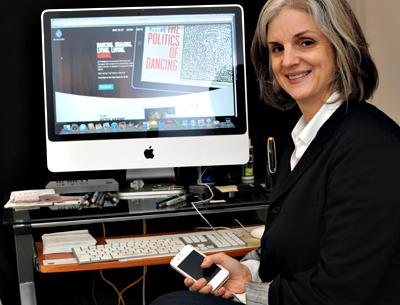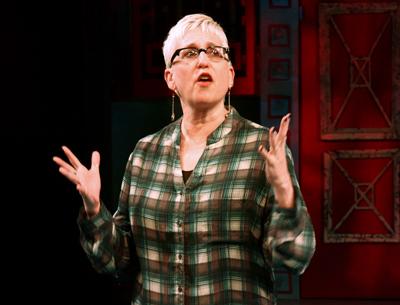A Trove of Art History, at Your Fingertips
A Trove of Art History, at Your Fingertips

Sometimes it can be hard to tell when a project or company has reached a tipping point. So often things can appear on the brink of a breakthrough and then fall just short of the last leap.
This is not the case with Art Intelligence, a relatively recent start-up that takes the best of old school art historical research and marries it to the latest in app technology to create a seamless narrative devoted to some of the more inventive and cross-cultural artists of the past few decades.
Bridget Goodbody, a Columbia University-trained art historian and former professor, art critic, and manager of Julian Schnabel’s studio, is the founder and curator of Art Intelligence, which has released two apps for iPad, one on Patricia Piccinini and one on Keith Haring, just launched this summer, with two more in the works on Cai Guo-Qiang and Cindy Sherman.
The part-time Amagansett resident has left the classroom behind for a new kind of teaching, one that crosses generational and technological divides to deliver a dynamic and fluid timeline of history focused not just on the artists in the app, but on their milieu, bringing to bear on their work’s meaning the world and cultural events happening at the time of its creation as well as key moments in the artist’s life.
“I’ve spent a lot of time in the classroom and as an art critic. When looking at an artwork you need to tell the viewer what it is, but everybody wants to know something different,” she said recently. “It’s not necessarily clear what it is that people are getting from a work of art, but they want it to be meaningful to them.” An app can allow for a personalized experience that can grow and deepen with continued use.
She said she worked with developers to design apps for the casual consumer, who can purchase them in the Apple App Store, as well as for educators who want to incorporate them into the classroom to study art and history and even as a way into scientific concerns. As an educational app in iTunesU, the company can offer discounts to high schools and universities. She said Apple has been very supportive of her efforts because they help raise the standard of what can be done with the format and how its visual and interactive components can be utilized in different ways, such as answering visual questions visually.
“People want an understanding of art. I think a lot of them are baffled by art experiences — ‘What am I supposed to think about it? How am I supposed to think about it?’ — There’s this hunger to ‘get it’ in so many ways.”
The Haring app, for example, incorporates a monograph’s worth of research but in ways that are purely interactive and not didactic. For more information on a particular painting, click on it. Up comes the title, date, medium, and some descriptive context. Then click above it for the historical events that were shaping the artist’s life and point of view at the time. Click below it on the timelime of the artist’s life to see what Haring was doing at the moment he was conceiving and realizing the work.
There is no omniscient narrator prating on about why this or that is important. All of the information presented is important, or at least pertinent. Its actual import comes from the particular interest of the viewers and where their exploration of it takes them on any given day.
The artists she has chosen have been eclectic, but they are tied to each other in that they transcend many genres and cross over into other concerns, be they science or science fiction, human rights, politics, music, popular culture, symbolism, or whatever else comes to mind. She credits her undergraduate work in anthropology for a more global and rounded approach to the artists she has chosen so far.
Ms. Piccinini, an Australian artist, is fascinated by the natural versus the manufactured as it is realized in biotechnology and consumer culture. Her invented cross-species mutations are very popular with science fiction enthusiasts as well as art audiences. “She gets people to think about the relationships between animals and humans. Artists are good at bringing different things together,” Ms. Goodbody said.
Haring, famously, had the whole ’70s and ’80s art and music scene as his backdrop. It is hard to imagine him out of the context of the Village People, Madonna, and Boy George, Danceteria, Mudd Club, and the Palladium. If he wasn’t in the clubs, his art was, and it was everywhere else as well: public murals and his Pop Shop store’s clothing and accessories. He was also an ardent member of the anti-apartheid movement and a voluble spokesman for gay rights and the understanding of AIDS, the disease that took his life.
Cindy Sherman, the latest to approve an app, offers a perfect platform to examine the image of women, from the earliest manifestations of her “Untitled Film Stills” to her recent “Society Portraits” series. In her long career, she has explored the essence of clowns, classical narrative painting, the fashion world, the semiotic power of mannequins, and other digressions of interest. Her active digestion of cultural norms and historic and current depictions of women can be placed in multiple contexts, shaped by endless events of recent history and should be a natural and dynamic subject for this format.
Ms. Goodbody won’t say which other artists she is working on getting, but she admits she has a long list. “The platform can work for a lot of different kinds of artists and even movements such as Abstract Expressionism.” Her work with the artists she has so far is keeping her rather busy these days. Although Ms. Sherman only recently signed, Ms. Goodbody has been in the stacks and reading rooms at the Columbia University library already, gathering research that predates the 1990s, which seems to be a cutoff point for a lot of digitization.
She has taken it upon herself to familiarize herself with at least the basics of the technology she is working in so that she can better discuss her needs with developers to make suggestions and describe formats she is reasonably certain can be achieved. She has also been active at various tech conferences and Apple’s own worldwide developer conference, which had 5,000 tickets that sold out in a minute (she credits her old concert-going days to making sure she was able to get one). “I’m the art historian among all of the engineers. It’s great to be around the makers, building and experimenting. . . . They’re really down to earth and interesting.”
What she has learned is that building an app is like constructing a building, and technology needs those with broader insights to help it reach its greatest potential. “You can make it do a certain thing, but will people like to live in it? Will they move around in it? Will it answer their needs? These are all humanities-based questions.”

